Do you suspect you have a bad car battery? There’s a difference between a battery that just got drained down too low, and a battery that can no longer hold a charge. But how do you know? You don’t want to buy a new battery if you don’t have to! This article explains exactly how to tell if your battery is bad or just needs a charge!
What you’ll need:
- voltmeter or cigarette lighter car battery tester
- wire brush
- sandpaper
- battery corrosion inhibitor
- anti-corrosion felt washers
- New Battery (hopefully not…)
Okay, let’s get started!
If you make purchases through links in this guide, I may earn a commission which doesn’t cost you anything extra but helps me with hosting fees and also allows me to keep banner ads off this site. Thank you.
Testing a Car Battery
To begin with, let’s assume your car won’t start and you are suspecting the problem is with the battery because you have already ruled out the alternator or starter. This was the case I had with my Honda Accord. The engine would “turn over,” but the cranking would slow down, and the car would not start. I could jump-start the car in order to get it going, and then it would run fine until the next time I had shut it off and went to start it again.
The battery was about 6 years old (so possibly near the end of its life), but I wanted to verify whether the battery was actually bad or not. And whether I would have to replace it…
Note: A car battery will last for 3 years. With many batteries lasting anywhere from 3-6 years.
Measure the Battery Voltage
The first thing to do is measure the voltage of the battery. It is important to note that the voltage of the battery can’t tell us for sure if the battery is good or bad, but it can tell us if the battery is low on voltage or not.
Ultimately we will need more information than just the battery voltage to tell us if the battery is bad. You will need to know the battery’s ability to deliver amperage to the starter motor. That being said, voltage can be a good start for diagnosing!
A fully charged car battery will have a voltage of 12.6 volts when the car is off. A completely dead battery will have a voltage of 12.0 volts or below. A car battery voltage should be between 13.7 and 14.7 volts when the car is running, indicating that alternator is charging the battery and it can sustain the voltage.
The following table gives some approximate voltages associated with various charge levels.
| Charge Level (%) | Battery Voltage (V) |
| 100% | > 12.6 volts |
| 75% | 12.5 volts |
| 50% | 12.3 volts |
| 25% | 12.1 volts |
| 0% | < 12.0 volts |
Make sure the car is off, then go ahead and pop the hood.
Note: If you don’t have a voltmeter, or don’t want to have to go under the hood, use a cigarette-lighter tester. These are really handy units you can keep plugged in all the time in the cabin of your car. It allows you to measure and assess the strength of your battery without popping the hood, or even getting out of the car!
Take your voltmeter and put it on the DC voltage setting (20 volt range). Press the negative probe to the negative (-) post of the battery and the positive probe to the positive (+) battery post.
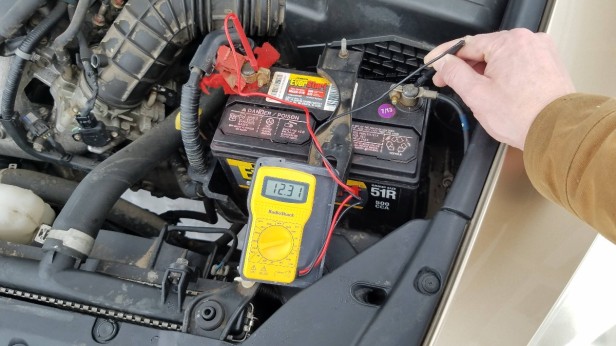
In this case, the car won’t start, and the battery is reading an slightly low voltage of 12.31 v, which corresponds to a battery at about 50% charge. It is possible that there is a problem with the battery connections.
Clean the Battery Connections
The next step is to clean the battery clamp connections. For a severely corroded battery, you may want to remove the battery and neutralize the corrosion.
Start by removing the negative battery clamp. This Honda Accord required a 10mm socket.
TIP: If there is a spark between the negative battery post and the clamp when you touch it to the post, this is a strong indication that something in the car is still drawing voltage from the battery. If this is the case, investigate what is drawing voltage, such as a dome light or the key not turning completely ‘off’. This could be the culprit that is draining your battery!
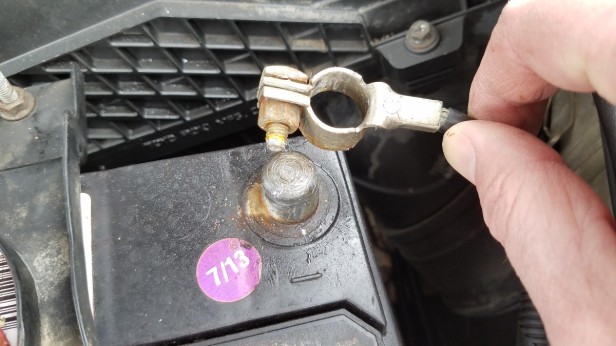
Then remove the positive battery clamp. Tuck these away so that they don’t accidentally come into contact with the battery post again while you are cleaning them.
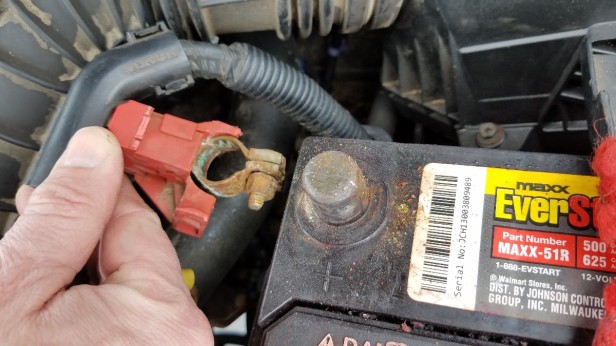
Take a wire brush and use it to scrape off the corrosion and build up on both battery posts.
Note: Don’t touch both battery posts at the same time with any conductive object as it will short the battery and cause a spark.
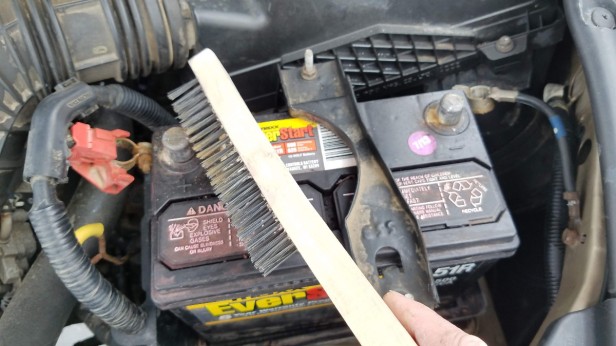
This is a photo of a well-cleaned battery post.
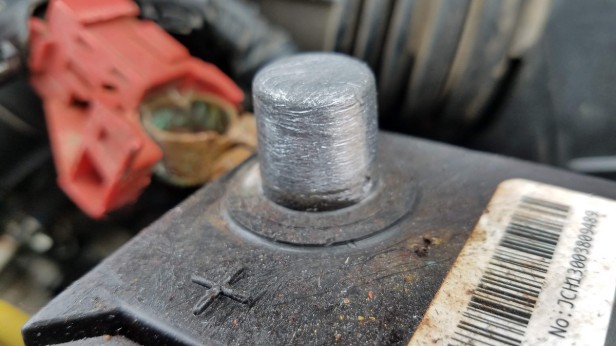
Next, scrape any corrosion, rust or build-up off of the battery clamp. This could be inhibiting the connection to the battery. Use a screwdriver or similar tool to scrape off the build-up.
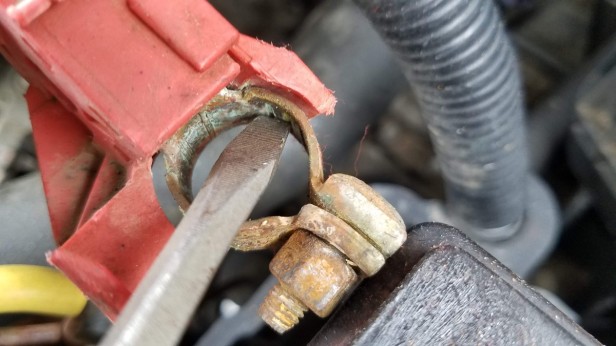
Use some sandpaper to get the rest of the corrosion off and score the surface a bit for a nice connection.
Note: Use gloves or wash your hands after performing these steps.
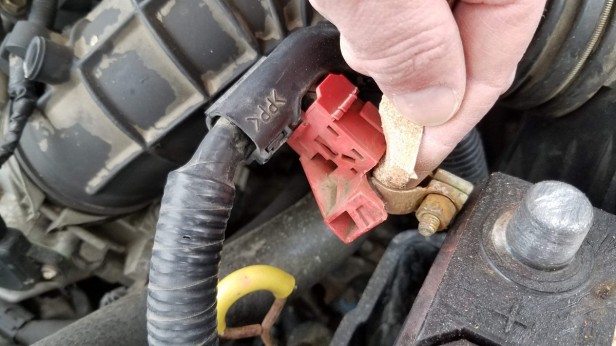
The following photo shows a cleaned battery clamp.
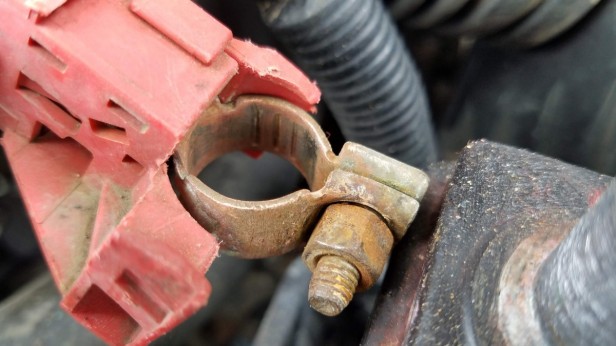
If you have some available, use some battery corrosion inhibitor and spray it on the battery post.
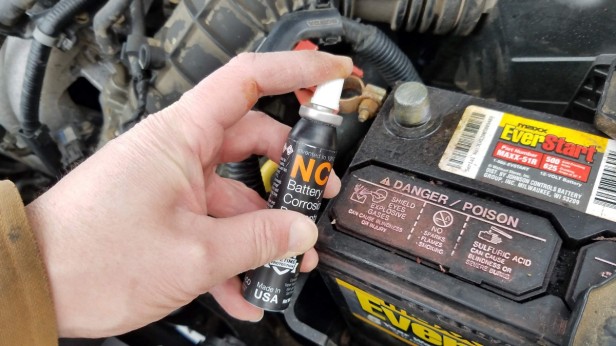
This is a photo of the battery post dosed with anti-corrosion spray.
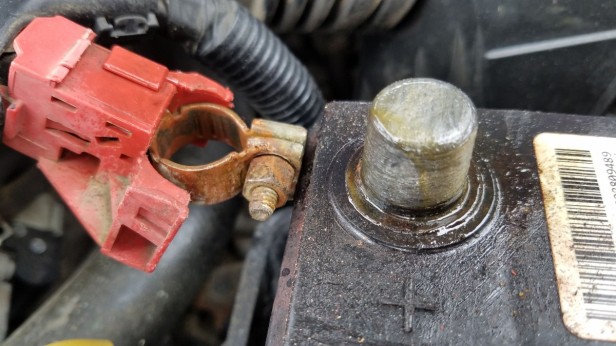
Next, put on some anti-corrosion felt washers.
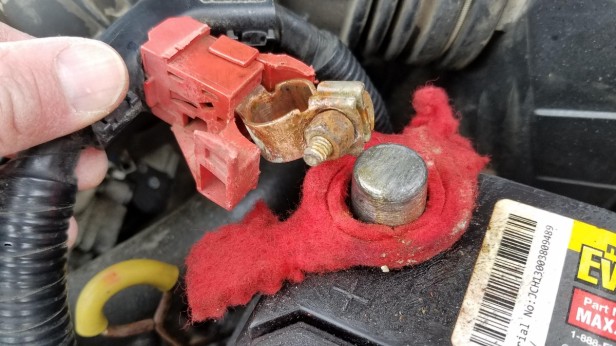
Then put the positive battery clamp back on.
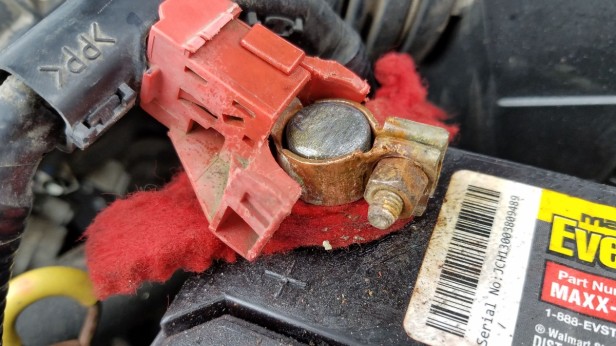
Tighten up the battery clamp. For this Honda Accord it was a 10mm socket.
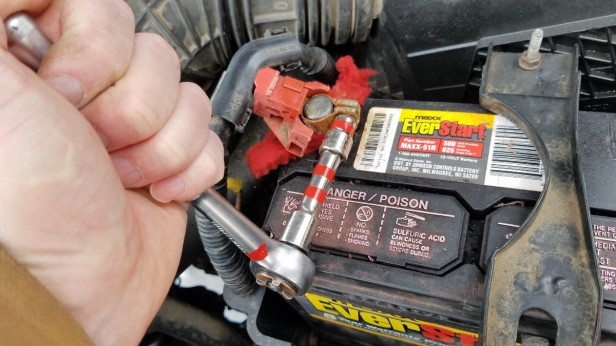
Put on and tighten up the negative battery terminal clamp.
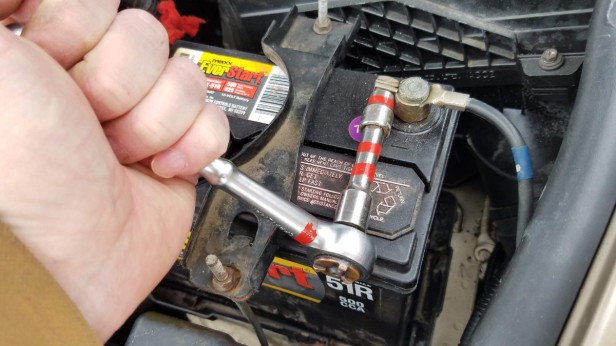
This is the battery after the posts and clamps have been cleaned up and reconnected.
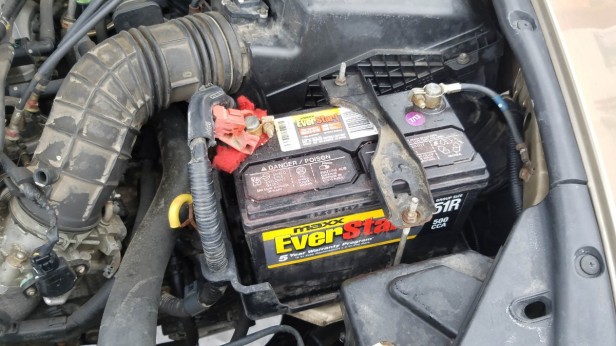
I then jump started the car and drove it for 45 minutes or so. I then checked the the battery voltage while the car was running. Recall that car battery voltage should be between 13.7 and 14.7 volts when the car is running, indicating that alternator is charging the battery and it can sustain the voltage.
In this case, the voltage was 14.39 volts, perfectly in range, indicating that the alternator and battery connections appear to be okay.
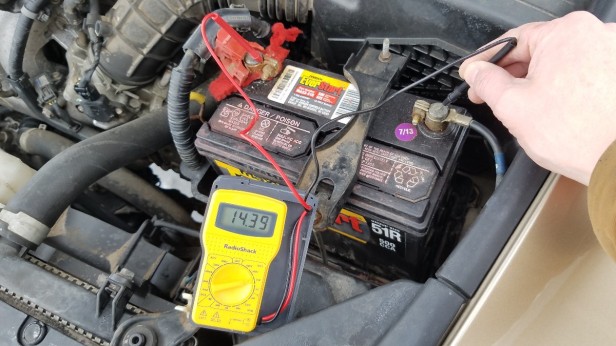
I then turned off the car and immediately attempted to start it. The car turned over a couple times then slowly ground to a halt. This is the classic case of a car battery that can no longer hold a charge. So I took this as the final nail in the coffin that I had to replace the battery.
I went to a Fleet Farm and traded in the old battery and bought a new one. After putting it in the car, I decided to check the voltage just for the fun of it.
As you can see below, the voltage of the battery was actually lower than the bad battery! 12.26v vs 12.31v…

With the car running, the voltage was 14.37 volts (compared to 14.39v!).
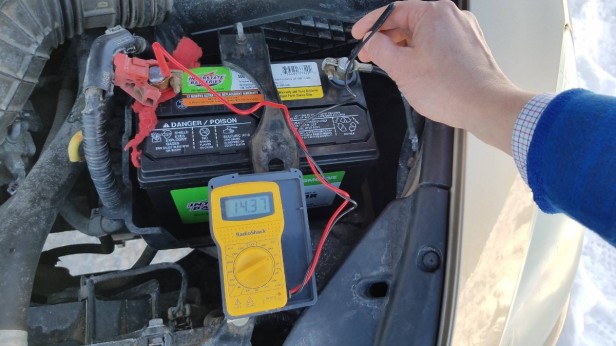
This is a good lesson that looking only at voltage is not a true indicator as to whether the battery is good or not…
For reference, here I list the voltages with the vehicle both off and running for several different vehicles. In this case, the “good” designation indicates that the vehicle is starting and operating normally. The “bad” designation refers to the values of the Accord referenced in this article. Notice that the voltages vary greatly. Another indicator that voltage is not necessarily the only parameter that matters when determining the condition of a car battery.
| Year | Vehicle | Battery Condition | Battery Age (months) | Voltage (Vehicle Off) | Voltage (Running) |
| 2004 | Honda Accord | Good | 3 | 12.26 | 14.37 |
| 1977 | Dodge W-200 | Good | 4 | 12.54 | 14.52 |
| 2006 | Toyota Sienna | Good | — | 12.50 | 14.26 |
| 2004 | Toyota Corolla | Good | 63 | 12.35 | 14.00 |
| 2004 | Honda Accord | Bad | 68 | 12.31 | 14.39 |
So, these were the tests I went through to determine that the battery was bad and needed to be replaced…
Conclusion
To recap, these were the deciding or contributing factors in determining that the battery was bad:
- The engine would “turn over,” but the cranking would slow down, and the car would not start.
- Cleaning the battery posts and connections and reconnecting them then charging the battery did not help.
- The voltage of the battery with the car off was at about 50% charge (12.3 v).
- The voltage of the battery with the car running was 14.39 volts, indicating that the alternator was working.
- After driving the vehicle on the highway for 45 minutes, then turning it off and attempting to re-start it, the engine turned over several times then ground to a halt and did not start.
Thanks for reading this post! I appreciate you as a reader, it really means a lot! Is there anything I missed? Have you had a similar experience; how did you determine the battery had finally given up the ghost? Let me know in the comments section at the end of the page!
Thanks!
Richard
Do you suspect you have a bad car battery? There’s a difference between a battery that just got drained down too low, and a battery that can no longer hold a charge. But how do you know? You don’t want to buy a new battery if you don’t have to! This article explains exactly how to tell if your battery is bad or just needs a charge!
What you’ll need:
- voltmeter or cigarette lighter car battery tester
- wire brush
- sand paper
- battery corrosion inhibitor
- anti-corrosion felt washers
- New Battery (hopefully not…)
Okay, let’s get started!
Testing a Car Battery
To begin with, let’s assume your car won’t start and you are suspecting the problem is with the battery because you have already ruled out the alternator or starter. This was the case I had with my Honda Accord. The engine would “turn over,” but the cranking would slow down, and the car would not start. I could jump-start the car in order to get it going, and then it would run fine until the next time I had shut it off and went to start it again.
The battery was about 6 years old (so possibly near the end of its life), but I wanted to verify whether the battery was actually bad or not. And whether I would have to replace it…
Note: A car battery will last for 3 years. With many batteries lasting anywhere from 3-6 years.
Measure the Battery Voltage
The first thing to do is measure the voltage of the battery. It is important to note that the voltage of the battery can’t tell us for sure if the battery is good or bad, but it can tell us if the battery is low on voltage or not.
Ultimately we will need more information than just the battery voltage to tell us if the battery is bad. You will need to know the battery’s ability to deliver amperage to the starter motor. That being said, voltage can be a good start for diagnosing!
A fully charged car battery will have a voltage of 12.6 volts when the car is off. A completely dead battery will have a voltage of 12.0 volts or below. A car battery voltage should be between 13.7 and 14.7 volts when the car is running, indicating that alternator is charging the battery and it can sustain the voltage.
The following table gives some approximate voltages associated with various charge levels.
| Charge Level (%) | Battery Voltage (V) |
| 100% | > 12.6 volts |
| 75% | 12.5 volts |
| 50% | 12.3 volts |
| 25% | 12.1 volts |
| 0% | < 12.0 volts |
Make sure the car is off, then go ahead and pop the hood.
Note: If you don’t have a voltmeter, or don’t want to have to go under the hood, use a cigarette-lighter tester. These are really handy units you can keep plugged in all the time in the cabin of your car. It allows you to measure and assess the strength of your battery without popping the hood, or even getting out of the car!
Take your voltmeter and put it on the DC voltage setting (20 volt range). Press the negative probe to the negative (-) post of the battery and the positive probe to the positive (+) battery post.

In this case, the car won’t start, and the battery is reading an slightly low voltage of 12.31 v, which corresponds to a battery at about 50% charge. It is possible that there is a problem with the battery connections.
Clean the Battery Connections
The next step is to clean the battery clamp connections. For a severely corroded battery, you may want to remove the battery and neutralize the corrosion.
Start by removing the negative battery clamp. This Honda Accord required a 10mm socket.
TIP: If there is a spark between the negative battery post and the clamp when you touch it to the post, this is a strong indication that something in the car is still drawing voltage from the battery. If this is the case, investigate what is drawing voltage, such as a dome light or the key not turning completely ‘off’. This could be the culprit that is draining your battery!

Then remove the positive battery clamp. Tuck these away so that they don’t accidentally come into contact with the battery post again while you are cleaning them.

Take a wire brush and use it to scrape off the corrosion and build up on both battery posts.
Note: Don’t touch both battery posts at the same time with any conductive object as it will short the battery and cause a spark.

This is a photo of a well-cleaned battery post.

Next, scrape any corrosion, rust or build-up off of the battery clamp. This could be inhibiting the connection to the battery. Use a screwdriver or similar tool to scrape off the build-up.

Use some sandpaper to get the rest of the corrosion off and score the surface a bit for a nice connection.
Note: Use gloves or wash your hands after performing these steps.

The following photo shows a cleaned battery clamp.

If you have some available, use some battery corrosion inhibitor and spray it on the battery post.

This is a photo of the battery post dosed with anti-corrosion spray.

Next, put on some anti-corrosion felt washers.

Then put the positive battery clamp back on.

Tighten up the battery clamp. For this Honda Accord it was a 10mm socket.

Put on and tighten up the negative battery terminal clamp.

This is the battery after the posts and clamps have been cleaned up and reconnected.

I then jump started the car and drove it for 45 minutes or so. I then checked the the battery voltage while the car was running. Recall that car battery voltage should be between 13.7 and 14.7 volts when the car is running, indicating that alternator is charging the battery and it can sustain the voltage.
In this case, the voltage was 14.39 volts, perfectly in range, indicating that the alternator and battery connections appear to be okay.

I then turned off the car and immediately attempted to start it. The car turned over a couple times then slowly ground to a halt. This is the classic case of a car battery that can no longer hold a charge. So I took this as the final nail in the coffin that I had to replace the battery.
I went to a Fleet Farm and traded in the old battery and bought a new one. After putting it in the car, I decided to check the voltage just for the fun of it.
As you can see below, the voltage of the battery was actually lower than the bad battery! 12.26v vs 12.31v…

With the car running, the voltage was 14.37 volts (compared to 14.39v!).

This is a good lesson that looking only at voltage is not a true indicator as to whether the battery is good or not…
For reference, here I list the voltages with the vehicle both off and running for several different vehicles. In this case, the “good” designation indicates that the vehicle is starting and operating normally. The “bad” designation refers to the values of the Accord referenced in this article. Notice that the voltages vary greatly. Another indicator that voltage is not necessarily the only parameter that matters when determining the condition of a car battery.
| Year | Vehicle | Battery Condition | Battery Age (months) | Voltage (Vehicle Off) | Voltage (Running) |
| 2004 | Honda Accord | Good | 3 | 12.26 | 14.37 |
| 1977 | Dodge W-200 | Good | 4 | 12.54 | 14.52 |
| 2006 | Toyota Sienna | Good | — | 12.50 | 14.26 |
| 2004 | Toyota Corolla | Good | 63 | 12.35 | 14.00 |
| 2004 | Honda Accord | Bad | 68 | 12.31 | 14.39 |
So, these were the tests I went through to determine that the battery was bad and needed to be replaced…
Conclusion
To recap, these were the deciding or contributing factors in determining that the battery was bad:
- The engine would “turn over,” but the cranking would slow down, and the car would not start.
- Cleaning the battery posts and connections and reconnecting them then charging the battery did not help.
- The voltage of the battery with the car off was at about 50% charge (12.3 v).
- The voltage of the battery with the car running was 14.39 volts, indicating that the alternator was working.
- After driving the vehicle on the highway for 45 minutes, then turning it off and attempting to re-start it, the engine turned over several times then ground to a halt and did not start.
Thanks for reading this post! I appreciate you as a reader, it really means a lot! Is there anything I missed? Have you had a similar experience; how did you determine the battery had finally given up the ghost? Let me know in the comments section at the end of the page!
Thanks!
Richard
Links to Items Discussed in this article:
- voltmeter or cigarette lighter car battery tester
- wire brush
- sand paper
- battery corrosion inhibitor
- anti-corrosion felt washers
- New Battery (hopefully not…)


Just the information I’ve been looking for. Based upon your article, I believe I’ll be able to use my battery for a little longer with some monitoring and care. Thank you.
Glad it helped!
I had just replaced an old battery to my 2006 Honda Odyssey, in early April of this year. It was doing good up until last week and then I have had to keep jump-starting the battery after a full day of not driving at all. I learned a little more about vehicle batteries after reading this article. But I still don’t understand what could be draining a fairly new battery.
Very helpful. My battery is just over 3 years old with a reading of 12.5 volts and it was slow to start this cold morning.
Very thorough! Like the pictures
Good and helpful information. Appreciated it so much!
Thanks John, glad you found it helpful!